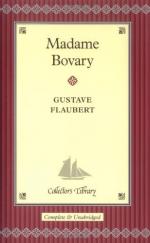He by no means gave up his shop. On the contrary, he kept well abreast of new discoveries. He followed the great movement of chocolates; he was the first to introduce “cocoa” and “revalenta” into the Seine-Inferieure. He was enthusiastic about the hydro-electric Pulvermacher chains; he wore one himself, and when at night he took off his flannel vest, Madame Homais stood quite dazzled before the golden spiral beneath which he was hidden, and felt her ardour redouble for this man more bandaged than a Scythian, and splendid as one of the Magi.
He had fine ideas about Emma’s tomb. First he proposed a broken column with some drapery, next a pyramid, then a Temple of Vesta, a sort of rotunda, or else a “mass of ruins.” And in all his plans Homais always stuck to the weeping willow, which he looked upon as the indispensable symbol of sorrow.
Charles and he made a journey to Rouen together to look at some tombs at a funeral furnisher’s, accompanied by an artist, one Vaufrylard, a friend of Bridoux’s, who made puns all the time. At last, after having examined some hundred designs, having ordered an estimate and made another journey to Rouen, Charles decided in favour of a mausoleum, which on the two principal sides was to have a “spirit bearing an extinguished torch.”
As to the inscription, Homais could think of nothing so fine as Sta viator*, and he got no further; he racked his brain, he constantly repeated Sta viator. At last he hit upon Amabilen conjugem calcas**, which was adopted.
* Rest traveler.
** Tread upon a loving wife.
A strange thing was that Bovary, while continually thinking of Emma, was forgetting her. He grew desperate as he felt this image fading from his memory in spite of all efforts to retain it. Yet every night he dreamt of her; it was always the same dream. He drew near her, but when he was about to clasp her she fell into decay in his arms.
For a week he was seen going to church in the evening. Monsieur Bournisien even paid him two or three visits, then gave him up. Moreover, the old fellow was growing intolerant, fanatic, said Homais. He thundered against the spirit of the age, and never failed, every other week, in his sermon, to recount the death agony of Voltaire, who died devouring his excrements, as everyone knows.
In spite of the economy with which Bovary lived, he was far from being able to pay off his old debts. Lheureux refused to renew any more bills. A distraint became imminent. Then he appealed to his mother, who consented to let him take a mortgage on her property, but with a great many recriminations against Emma; and in return for her sacrifice she asked for a shawl that had escaped the depredations of Felicite. Charles refused to give it her; they quarrelled.
She made the first overtures of reconciliation by offering to have the little girl, who could help her in the house, to live with her. Charles consented to this, but when the time for parting came, all his courage failed him. Then there was a final, complete rupture.




